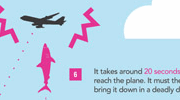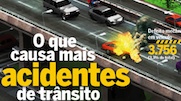Infographics in the classroom
 Yesterday I read an article at Bionic Teaching that featured an “infographic” by Stephen Taubman. Based on a cheesy 2009 sci-fi flick, Taubman’s Mega Shark poster explains the physics of an enormous creature leaping out of the ocean and bringing down an airplane (I’m not making this up). It’s a beautifully crafted image that cleverly connects science fiction to real science – great for the classroom, don’t you think?
Yesterday I read an article at Bionic Teaching that featured an “infographic” by Stephen Taubman. Based on a cheesy 2009 sci-fi flick, Taubman’s Mega Shark poster explains the physics of an enormous creature leaping out of the ocean and bringing down an airplane (I’m not making this up). It’s a beautifully crafted image that cleverly connects science fiction to real science – great for the classroom, don’t you think?
Infographics are visual representations designed to quickly explain complex information. They are used by journalists, computer scientists, mathematicians, educators, and others who need to communicate concepts clearly. Well-known examples of infographics include the illustrations in David Macaulay’s best-selling The New Way Things Work, as well as USA Today’s snapshot graphics, and the Weather Channel’s maps.
 Infographics can feature pictures, charts, diagrams, graphs, tables, maps, lists, time lines, flowcharts, and more. A picture may be worth a thousand words, but these pictures usually include text. And they often incorporate a metaphor to help get the point across. For example, a Brazilian infographic about the causes of accidents is set on a busy city freeway interchange.
Infographics can feature pictures, charts, diagrams, graphs, tables, maps, lists, time lines, flowcharts, and more. A picture may be worth a thousand words, but these pictures usually include text. And they often incorporate a metaphor to help get the point across. For example, a Brazilian infographic about the causes of accidents is set on a busy city freeway interchange.
It’s not hard to see the potential value of infographics in teaching and learning. Visually appealing designs can draw learners in quickly, and a well-conceived metaphor can turn an intellectual chore into a game-like experience. Memorable infographics can also provide visual learners a solid mental framework within which to store new ideas. What’s not to like?
Infographics are likely to be large, so on-screen viewing may pose a bit of a challenge. When you zoom out to see the whole thing, text may become too small to read. Try using a simple image viewer (like “Preview” on the Mac) to open, zoom in and move around. With a small group you might choose to print out a few 11″ x 17″ color copies ($1 each) for students to share in class.
[tweetmeme] Below I have listed a few sources for ready-made infographics. A persistent (or lucky) professor might find an appropriate one for a specific topic, but it’s not impossible to make your own. One strategy is to combine elements made with different tools. You can create SmartArt with PowerPoint, maps with Google Maps, time lines with Xtimeline, concept maps with Xmind … even incorporate a comic from Pixton.
You may discover that it’s relatively easy to find tools, but hard to come up with a strategy for representing the information. Why not have students propose designs for infographics? They could work as individuals or groups, tackling a single problem or different ones. They wouldn’t need to create a product, just describe it and maybe do a rough sketch. Then you could pick the best ideas and turn them into infographics. You could DIY (do it yourself), but if you’re at Notre Dame the Learning Technology Lab would be glad to help.
Here’s some inspiration to get you started:
- Cool Infographics – visualizations and infographics from the media and the Internet
- Information is Beautiful – David McCandless
- Infographics at GOOD Magazine – for people who want to live well and do good
- Show Me Now – illustrated step-by-step tutorials on all kinds of things
- Strange Maps – just what it says
- Many Eyes – samples of other people’s work and ways to create your own
- Infografia | Infographics and Info Graphics – pools of images at Flickr
Let us notify you of new articles! -> subscribe by email or use Google Reader

Trackbacks